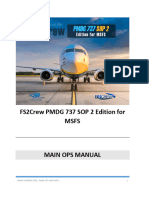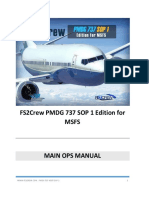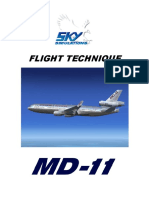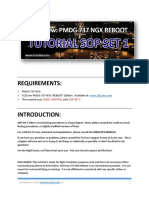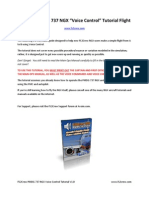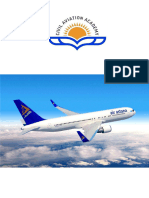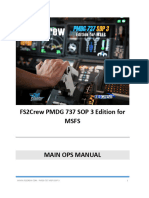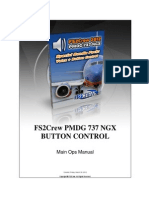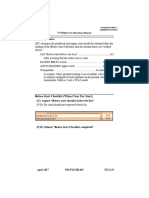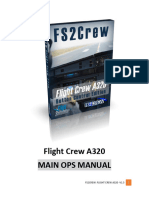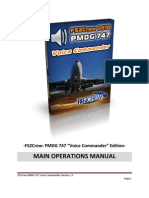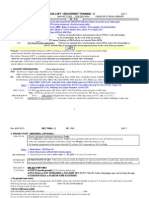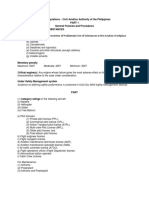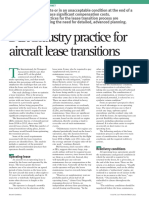Requirements:: PMDG 737 Ngxu Fs2Crew PMDG 737 Ngxu Edition. Available At: This Tutorial Uses With
Requirements:: PMDG 737 Ngxu Fs2Crew PMDG 737 Ngxu Edition. Available At: This Tutorial Uses With
Uploaded by
rondon9897Copyright:
Available Formats
Requirements:: PMDG 737 Ngxu Fs2Crew PMDG 737 Ngxu Edition. Available At: This Tutorial Uses With
Requirements:: PMDG 737 Ngxu Fs2Crew PMDG 737 Ngxu Edition. Available At: This Tutorial Uses With
Uploaded by
rondon9897Original Title
Copyright
Available Formats
Share this document
Did you find this document useful?
Is this content inappropriate?
Copyright:
Available Formats
Requirements:: PMDG 737 Ngxu Fs2Crew PMDG 737 Ngxu Edition. Available At: This Tutorial Uses With
Requirements:: PMDG 737 Ngxu Fs2Crew PMDG 737 Ngxu Edition. Available At: This Tutorial Uses With
Uploaded by
rondon9897Copyright:
Available Formats
REQUIREMENTS:
✓ PMDG 737 NGXu
✓ FS2Crew PMDG 737 NGXu Edition. Available at: https://www.fs2crew.com
✓ This tutorial uses VOICE CONTROL with SOP SET 1
INTRODUCTION:
SOP Set 1 follows stock Boeing procedures to a large degree. Many airlines around the world use stock
Boeing procedures, or slightly modified versions of them.
For a full list of voice commands and explanations, please consult the MAIN OPS MANUAL.
If you have any questions or problems, please consult the FS2Crew Support Forum at Avsim.com. This is
complex software and we’re trying to do things as realistically as possible, so don’t be afraid to ask
questions!
For the Flight Route, we’ll leave that up to you. Pick your favorite airport and fly there!
DISCLAIMER: This tutorial is made for flight simulation purposes only and does not necessary reflect
real world procedures to their fullest. FS2Crew 737 NGXu is an entertainment product. It is not meant
for real-world flying or training. It is not affiliated or associated with any specific airline or company.
TUTORIAL SOP 1 VOICE CONTROL - FS2CREW NGXU 1
LET’S BEGIN:
▪ If you haven’t already trained your voice and set your speech recognizer to ENGLISH – US,
please do so now. Please consult the MAIN OPS MANUAL for detailed info.
▪ Load the PMDG 737 NGXu from the Free Flight screen. The PMDG 737 should never be the
default aircraft that loads or you WILL have problems. Do not used saved situation files!
▪ At this point, you should be sitting in the cockpit and the engines should be running. If the
engines are not running, you are probably using a default panel state file, and we generally don’t
recommend using those as they can sometimes cause the aircraft to initialize improperly.
▪ We need to shut off the built in F/O CALLOUTS or you will get double call outs via the PMDG –
OPTIONS - SIMULATION menu as shown below:
▪ We recommend that the F/O's altimeter and Standby altimeter syncs to the Captain's altimeter
as shown below.
SYNC CAPT AND F/O EFIS TO: BARO AND MINIMUMS.
SYNC CAPT AND STBY BARO TO 'YES'.
TUTORIAL SOP 1 VOICE CONTROL - FS2CREW NGXU 2
Note: The other options, such as Service-Based failures, can be set at your discretion.
▪ We recommend using EGPWS auto-callouts for the “MINIMUMS” and “PLUS HUNDRED” calls
during approach. Please ensure your PMDG Options are set accordingly as shown below:
▪ Open the PMDG’s FMC and select the stock PMDG LONG or SHORT PANEL STATE file. It’s your
choice. You don’t need to do this for every flight. In fact, you can start with the engines
running. But for the sake of this tutorial we’re going to start with the engines off. These two
panel states are generally the most realistic panel state files to use since airline pilots rarely
receive the aircraft cold and dark and most major airports supply ground power and air.
TUTORIAL SOP 1 VOICE CONTROL - FS2CREW NGXU 3
▪ Now we need to open the MAIN PANEL. There is no click spot! Press the button you assigned
to open the FS2Crew MAIN PANEL (namely the one linked to AUTOFEATHER ARM/OFF.) If you
haven’t already assigned a button to this event, do it now, or you won’t be able to open the
MAIN PANEL.
▪ The FS2Crew MAIN PANEL should open. It looks like this:
TUTORIAL SOP 1 VOICE CONTROL - FS2CREW NGXU 4
If the Main Panel does not open, double check your keyboard assignment that you assigned to
AUTOFEATHER (ARM/OFF). I personally use the “N” key on the keyboard. If the MAIN PANEL
still doesn’t appear, try assigning a different key. Also open the PMDG 737’s panel.cfg file with
Notepad. Make sure there are FS2Crew entries on it. If not, you forgot to Enable FS2Crew via
the FS2Crew NGXu Configurator or you have a write permission issue.
The PMDG 737 NGXu’s panel.cfg file is located here:
Your Flightsim Folder\SimObjects\Airplanes\PMDG 737-800NGXu\panel\panel.cfg
▪ Press the SEC button on the MAIN PANEL. A new panel should open that looks like an FMC. This
panel is called the SECONDARY PANEL.
TUTORIAL SOP 1 VOICE CONTROL - FS2CREW NGXU 5
▪ Press the CFG button on the FMC to open the CONFIG menu.
▪ Press LSK 1 (Left Line Select Button) to open the SETUP page.
▪ By default, FS2Crew is running in BUTTON CONTROL mode. We need to change that to VOICE
CONTROL.
▪ Press LSK 1 to change the Interface to VOICE CONTROL.
▪ Press LSK 4 to change the SOPS to SET 1.
▪ The text “CONFIRM SOP OVERWRITE” will appear on the same page.
▪ Press LSK 14 to confirm the overwrite. The various CALLOUTS CFG options will then be updated
to match SET 1’s SOPs.
▪ Press the AUDIO button on the SECONDARY PANEL.
▪ Select your CREW REGION by pressing LSK 1. This setting controls the regional accent of the
crew.
▪ If you are using a headset, select the audio device associated with your headset by pressing LSK
4 (HEADSET AUDIO DEVICE).
▪ Press LSK 7 to play the audio test. From your main speakers, you should hear “Left speaker
test…. Right speaker test… Audio test complete”.
▪ Note the button that says RESET AUDIO SYSTEM. Only press that if you seem to lose FS2Crew
audio; that can happen if your audio device momentarily disconnects from the system.
▪ Now we need to run the Pre-Flight events. Running the Pre-Flight events is OPTIONAL, but we’ll
run it anyway for the sake of the tutorial.
▪ Press the PF button on the SECONDARY PANEL to open the PRE FLIGHT EVENTS page.
▪ Press LSK 4 to run the Preflight Events (your engines must be shutdown first).
▪ To close the SECONDARY PANEL, press the SEC button on the FS2Crew Main Panel, or click the
right screw in the top right hand corner of the SECONDARY PANEL or press the button you
assigned to toggle the SECONDARY PANEL.
TUTORIAL SOP 1 VOICE CONTROL - FS2CREW NGXU 6
SOME SIMPLE RULES AND ADVICE:
▪ In FS2Crew, you are the Captain and the Pilot Flying (PF). The computer is the FO and the Pilot
Monitoring (PM).
▪ If the Autopilot is ON, the MCP (autopilot panel) falls within your area of responsibility. The
FO/PM should generally never touch the MCP if the autopilot is on.
▪ It’s highly recommended that you leave the Green Bar on so you can see what the speech
recognition system is detecting.
PRE-FLIGHT EVENTS:
The Pre-Flight events are short and intense. These day quick turn arounds are the norm as airlines try to
save money. Don’t doddle or you will be behind the curve!
This tutorial only covers the key points. For specific details, please consult the FCOMs provided with the
NGX. Furthermore, this tutorial assumes it’s the first flight of the day for the crew.
Special Note: To FAST FORWARD the PRE FLIGHT EVENTS TIME, RIGHT CLICK the DOWN ARROW on the
FS2Crew Main Panel.
NOTE: All times listed below are approximate.
+25 Minutes: Pre-Flight Events start. Jetway connects if available. Door 1L and cargo doors
open.
+24 Minutes: ONLY if using the COLD AND DARK panel state (the aircraft has no electrical
power) the FO starts the ELECTRICAL POWER UP SUPPLEMENTRY PROCEDURE unless you’ve
selected otherwise in the FS2Crew Options menu. Note that in real life, pilots rarely receive the
aircraft cold and dark.
ELECTRICAL POWER UP SUPPLEMENATRY PROCEDURE
-CAPTAIN OR FO. TUTORIAL ASSUMES FO WILL DO IT BASED ON DEFAULT CONFIG OPTION.
BATTERY ON
GROUND POWER SWITCH ON (IF GROUND POWER AVAILABLE)
FIRE TESTS (FAULT/INOP, OVHT FIRE, EXTINGUISHER)
START APU IF GROUND POWER NOT AVAILABLE
CONFIGURE FUEL PUMPS
WHEEL WELL FIRE TEST
TUTORIAL SOP 1 VOICE CONTROL - FS2CREW NGXU 7
+23 Minutes: You as the Captain should perform the PRELIMINARY PREFLIGHT PROCEDURE. By
convention, the Captain will usually perform this procedure if the FO is doing the walk around.
If you want the FO to perform this procedure instead of you, select the associated FS2Crew CFG
option.
PRELIMINARY PREFLIGHT PROCEDURE
-CAPTAIN OR FO. TUTORIAL ASSUMES CAPTAIN WILL DO IT BASED ON DEFAULT CONFIG
OPTION.
IRSs OFF, WAIT APPROX 30 SECONDS, THEN ON
FLIGHT RECORDER TEST
VOICE RECORDER SWITCH NORMAL
SERVICE INTERPHONE SWITCH OFF
ENGINE PANEL SET
MACH OVERSPEED TEST
STALL WARNING TEST (NOTE: REQUIRES AC TRANSFER BUSSES ARE POWERED FOR UP
TO 4 MINUTES. YOU MAY WISH TO DELAY RUNNING THE FS2CREW PRE-FLIGHT
EVENTS BY 4 MINUTES TO ACCOUNT FOR THIS CONDITION.)
SET PARKING BRAKE (IF BRAKE WEAR INDICATORS WILL BE CHECKED DURING THE
EXTERIOR INSPECTION)
ATIS COPY (NOT SIMULATED)
+ 22 Minutes: FO starts walk around if he/she hasn’t already left. If it’s night, the FO will turn on
the wheel well light. Captain performs the CDU pre-flight using the estimated ZFW.
+19 Minutes: FA asks if she can start the boarding. Respond: “YES PLEASE/ GO FOR IT/ OKAY”.
Actual boarding will commence approximately two minute later.
+18 Minutes: FO returns from walk around and starts his PREFLIGHT and CDU PREFLIGHT
PROCEDURE. Capt starts his PRE FLIGHT PROCEDURE.
TUTORIAL SOP 1 VOICE CONTROL - FS2CREW NGXU 8
PREFLIGHT PROCEDURE
-CAPTAIN
MASTER LIGHTS TEST AND DIM SWITCH TEST
EFIS CONTROL PANEL SET (MINIMUMS REF SELECTOR BARO, MINIMUMS SELECTOR
EFFRA, FLIGHT PATH VECTOR SWITCH AS NEEDED, BAROMETRIC REFERENCE SELECTOR
IN OR HPA, BAROMETIC SELECTOR SET LOCAL ALTIMETER SETTING, VOR/ADF
SWITCHES AS NEEDED, MODE SELECTOR MAP, WEATHER RADAR OFF)
MODE CONTROL PANEL SET (COURSES SET , FLIGHT DIRECTORS ON, IAS TO V2, BANK
ANGLE SELECTOR AS NEEDED, ALT SELECTOR TO 4900 FEET UNTIL AIRWAYS
CLEARANCE RECEIVED)
OXYGEN TEST AND SET
FLIGHT AND STANDBY INSTRUMENTS CHECK
PARKING BRAKE SET
SET NAV RADIOS
AUDIO CONTROL PANEL SET
TRIMS CHECK FREE AND SET TO 0
VERIFY FLIGHT PLAN
TUTORIAL SOP 1 VOICE CONTROL - FS2CREW NGXU 9
PREFLIGHT PROCEDURE
-FIRST OFFICER. TUTORIAL ASSUMES FO WILL DO IT BASED ON DEFAULT CONFIG OPTION.
NOTE: The various tests (CVR, WX RADAR, TCAS, GPWS) are not part of the normal Preflight
Procedure, and are not usually run in during everyday operations. They are ‘Supplementary
Procedures’. However, if you want the FO to run the Supplementary Procedures during his
Preflight flow, select the “PREFLIGHT SUP PROC to “YES” in the FS2Crew Config Options.
YAW DAMPER ON
NAVIGATION AND DISPLAYS PANEL SET
FUEL PANEL SET
ELECTRICAL PANEL SET
FIRE DETECTION TESTS IF NOT COMPLETED DURING ELECTRICAL POWER UP
EMERGENCY EXIT LIGHTS ARMED
WINDOWS HEAT ON
PROBE HEAT OFF (ON IF COLD WX OPS)
HYDRAULIC PANEL SET
AIR CONDITIONING PANEL SET
CABIN PRESSURIZATION PANEL SET
IGNITION SWITCH RIGHT
LIGHTING PANEL SET
OXYGEN TEST AND SET
DISENGAGE LIGHTS TEST
FLIGHT INSTRUMENTS CHECK
AUTOBRAKE RTO
CARGO FIRE TEST
AUDIO CONTROL PANEL SET
WEATHER RADAR CONTROL PANEL SET
TRANSPONDER CONTROL PANEL SET
At the end of the pre-flight procedure, and if “FUEL UPLOADED REQUIRED” selected to “YES” on
the FS2CREW SETUP page, the ground crew will hand the FO the fuel receipt.
+11 Minutes or later: Run the Pre Flight Checklist. Speak: “PRE FLIGHT CHECKLIST (PLEASE)”.
TUTORIAL SOP 1 VOICE CONTROL - FS2CREW NGXU 10
Checklist Notes:
B = Responded by both flight crew members.
F = Responded by the FO only.
C = Responded by the Captain only.
Items in RED TEXT are to be spoken by you, the Captain.
The FO will respond to many of his own challenges if the item falls within his area of
responsibility.
If you ever get stuck on a checklist item due to a speech recognition issue, speak “SET AND
CHECKED”.
PREFLIGHT CHECKLIST (PLEASE)
OXYGEN (B) TESTED, 100%
NAV TRANSFER & DISPLAY SWITCHES (F) NORMAL, AUTO
WINDOW HEAT (F) ON
PRESSURIZATION MODE SELECTOR (F) AUTO
FLIGHT INSTRUMENTS (B) HEADING ___, ALTIMETER __*
PARKING BRAKE (C) SET
ENGINE START LEVERS (C) CUTOFF
▪ Trigger key phrase is “ALTIMETER XXXX”. Example: “ALTIMETER TWO NINE NINE TWO”.
Ensure this phrase is said clearly and distinctly from the previously spoken Heading
value. Pause a second after saying ‘Heading XXX’.
▪ “HEADING” refers to the aircraft heading shown on the PFD, not the heading value
dialed in the MCP.
+10 Minutes: Obtain your airways clearance if using ATC. (In FS2Crew, this is done by the
Captain, but in real-life it’s usually done by the FO). Once you’ve received the clearance, enter
your cleared Altitude in the MCP Altitude Window.
+9 Minutes: Run the Departure Brief. There are two options: You can open the FS2Crew
SECONDARY PANEL and press DEP to and play the Departure Brief there. Or you can speak:
“ARE YOU READY FOR THE DEPARTURE BRIEF?” Close the brief by asking: “ANY QUESTIONS?”
+7 Minutes: Load sheet arrives. If load sheet arrives in person and not via ACARS (as defined in
the Config Options), respond: “THANK YOU/ OKAY THANKS/ THANKS”.
+6 Minutes: The FO will ask you if you want to start the APU if the Air Start Cart is not connected
and the APU is off. Note that the PMDG LONG PANEL STATE uses the Air Start Cart. Reply “YES
PLEASE / GO FOR IT/ OKAY / NO”. Note: You have a 10 second window to reply.
TUTORIAL SOP 1 VOICE CONTROL - FS2CREW NGXU 11
+5 Minutes: Update the FMC if required. Once CDU PREFLIGHT is complete and the load sheet
has been reviewed:
ARM AUTOTHROTTLE
SET V2 IN MCP
ARM LNAV/VNAV AS REQUIRED. DO NOT ARM LNAV IF EXPECTING VECTORS OR NOT
DEPARTING ON A SID
+3 Minutes: Cargo doors close.
+1 Minute: Boarding is complete. The FA will notify you that the cabin is ready and if she can
close the cockpit door. Respond: “THANKS / THANKS IT WILL BE A SHORT TAXI / THANKS IT WILL
BE A LONG TAXI / CLEARED TO CLOSE SHORT TAXI / CLEARED TO CLOSE LONG TAXI”.
+1 Minute: If the Air Start Cart is not connected and the APU is running and on the busses, the
wheel chocks will be automatically removed. The Air Conditioning Cart will also be removed if it
is connected.
+1 Minute: If desired, required permission from the Ground Crew to pressurize the hydraulics.
Speak: “COCKPIT TO GROUND”…. “CAN WE PRESSURIZE THE HYDRAULICS?” NOTE: Making this
request will override your FS2Crew CFG Option to have HYD SYSTEM A depressurized. The FO
will turn on HYD A PUMPS during his Before Start Flow regardless of your CFG setting. Unless
the Air Start Cart is required for engine start, ask the Ground Crew to disconnect the ground
equipment. Ensure you have a power source on-line first, such as the APU!
+ 0 Minutes: After being cleared for engine start (not simulated) and after the exterior doors are
closed, and, if desired, after ground has cleared you to pressurize the hydraulics, speak:
“BEFORE START PROCEDURE” and perform the BEFORE START PROCEDURE.
BEFORE START PROCEDURE
-CAPTAIN
SELECT TAKEOFF PAGE ON CDU
FLIGHT DECK WINDOWS LOCKED
OBTAIN CLEARANCE TO PRESSURIZE THE HYDRAULICS AND START THE ENGINES
TAKEOFF TRIM / RUDDER & AILERON TRIM SET
TUTORIAL SOP 1 VOICE CONTROL - FS2CREW NGXU 12
BEFORE START PROCEDURE
-FIRST OFFICER
FLIGHT DECK DOOR CLOSED AND LOCKED
SELECT LEGS PAGE ON CDU
EXTERIOR DOORS VERIFY CLOSED
FLIGHT DECK WINDOWS LOCKED
FUEL PANEL SET
HYDRAULIC PANEL SET (HYD A PUMPS OFF IF PUSHBACK REQUIRED AND ASSOCIATED
CFG OPTION SELECTED).
ANTI COLLISION LIGHT ON
LOWER DU TO ENGINE
+0 Minutes: Speak: “BEFORE START CHECKLIST”.
BEFORE START CHECKLIST (PLEASE)
FLIGHT DECK DOOR (F) CLOSED AND LOCKED
MCP (C) V2____, HEADING____, ALTITUDE___*
TAKEOFF SPEEDS (C) V1____, VR____, V2___*
CDU PREFLIGHT (C) COMPLETED
RUDDER AND AILERON TRIM (C) FREE AND ZERO
TAXI AND TAKEOFF BRIEFING (C) COMPLETED
ANTI COLLISION LIGHT (F) ON
▪ Trigger key phrase is “ALTITUDE”. Example: “ALTITUDE SEVEN THOUSAND / ALTITUDE
FLIGHT LEVEL NINE ZERO”. Ensure this phrase is said clearly and distinctly from the
previously spoken heading value.
▪ Trigger key phrase is “VEE TWO”. Example: “VEE TWO IS ONE FOUR SIX”. Ensure this
phrase is said clearly and distinctly from the previously spoken VR value.
+ 0 Minutes: Pushback and Engine Start.
TUTORIAL SOP 1 VOICE CONTROL - FS2CREW NGXU 13
PUSHBACK AND ENGINE START:
▪ For pushback, use the built in PMDG pushback until Ultimate Ground Crew X is released.
▪ Speak “START SEQUENCE IS TWO THEN ONE”.
▪ Use one of the following voice commands to start engine two:
o START NUMBER TWO ENGINE
o START ENGINE TWO
o START RIGHT ENGINE
o TURN NUMBER TWO
▪ At around 25 percent N2, manually move the right fuel control lever to IDLE CUTOFF.
▪ The FO will call “STARTER CUTOUT” when the START VALVE LIGHT extinguishes.
Special Note: If you experience that the FO calls “Starter Cutout”
before he should, ensure you have no hardware or other controls
assigned to the stock FS “Mixture” control event.
▪ If it’s a hot day and you delayed the APU start (if using the APU at all), command the FO to isolate a
pack after engine two stabilizes. This will help get cool air to the passengers since the engines can
cool the plane faster than APU bleed air. Speak: “ISOLATE A PACK”.
▪ Start Engine 1 using the same procedure.
▪ Note: If doing a cross bleed start, the start sequence would be one then two.
CROSS BLEED ENGINE START
▪ Cross Bleed starts are generally only used if the APU is inoperative.
▪ Speak: “START SEQUENCE IS ONE THEN TWO”.
▪ If engine 1 is not running, speak: “START ENGINE ONE”.
▪ After engine 1 has started, advance the throttle on engine 1 until the bleed duct pressure is about
30 PSI.
▪ Speak: “START ENGINE TWO CROSS BLEED START”.
TUTORIAL SOP 1 VOICE CONTROL - FS2CREW NGXU 14
BEFORE TAXI PROCEDURE:
▪ The FO will automatically start his BEFORE TAXI PROCEDURE after both engine have stabilized. He
will complete all actions up to and including the ENGINE START SWITCHES. Then he will wait for you
to request the Takeoff Flaps and complete the Flight Controls Check before completing the
remaining items in his flow. To ask for the Takeoff Flaps, speak, for example, “FLAPS FIVE” or
whatever takeoff flap you desire to use.
BEFORE TAXI PROCEDURE
-CAPTAIN
COMMAND THE FO TO SET THE TAKEOFF FLAP AFTER THE FO SETS THE ENGINE START
SWITCHES TO CONTINUOUS
FLIGHT CONTROLS CHECK PERFORM
BEFORE TAXI PROCEDURE
-FIRST OFFICER
EAI/WAI ON IMMEDIATELY AFTER ENGINE START IF REQUIRED
ENGINE GENERATORS ON
PROBE HEAT ON
PACKS AUTO
APU OFF
ENGINE START SWITCHES CONTINOUS
BLANK LOWER DISPLAY UNIT
AFTER “FLIGHT CONTROLS CHECK COMPLETE”:
TRANSPONDER AS REQUIRED (After Flight
RECALL
▪ After you’ve called for the Takeoff Flaps, It’s time to run the flight controls check. Speak: “CONTROL
CHECK” or “FLIGHT CONTROLS CHECK.”
▪ Move the control column fully left and speak “FULL LEFT… CENTER”.
▪ Move the control column fully right and speak “FULL RIGHT… CENTER”
▪ The FO will respond “CHECKED”.
▪ Perform the same check with the elevators: “FULL UP… FULL DOWN… CENTER.”
▪ Then rudders: “FULL LEFT… CENTER… FULL RIGHT… CENTER”.
▪ When done, speak “FLIGHT CONTROLS CHECK COMPLETE.” That phrase is the trigger for the FO to
complete the remaining two items in his procedure. DO NOT FORGET TO SPEAK THIS PHRASE OR
THE FO WILL NOT COMPLETE HIS FLOW.
▪ Now it’s time to run the Before Taxi Checklist. Speak: “BEFORE TAXI CHECKLIST (PLEASE)”.
▪ If it’s night, the FO will turn off the Dome Light at the end of the checklist.
TUTORIAL SOP 1 VOICE CONTROL - FS2CREW NGXU 15
▪ The FO will turn on the TAXI LIGHT, and, if it’s night, the RUNWAY TURN OFF LIGHTS after the
GROUND EQUIPMENT CHALLENGE.
BEFORE TAXI CHECKLIST (PLEASE)
GENERATORS (F) ON
PROBE HEAT (F) ON
ANTI-ICE (F) _____
ISOLATION VALVE (F) AUTO / CLOSED
ENGINE START SWITCHES (F) CONT
RECALL (B) CHECKED
AUTOBRAKE (F) RTO
ENGINE START LEVERS (C) IDLE DETENT
FLIGHT CONTROLS (C) CHECKED
GROUND EQUIPMENT (B) CLEAR
COLD WEATHER PROCEDURES
▪ During the Before Taxi procedure, instead of calling for the Takeoff Flaps, speak: “LEAVE THE FLAPS
UP FOR TAXI”.
▪ When near the runway, call for the desired takeoff flap PRIOR to calling for the BEFORE TAKEOFF
CHECKLIST. Example: “FLAPS 5”.
TAXI:
▪ Optional: Speak “CLEAR LEFT / CLEAR ON THE LEFT” even though it’s redundant.
▪ The FO will blank the lower screen.
▪ Taxi to runway.
TUTORIAL SOP 1 VOICE CONTROL - FS2CREW NGXU 16
APPROACHING RUNWAY:
▪ The FA will notify the cockpit that the cabin is secure. The FO will answer the service interphone
and notify you that the cabin is secure. Note: You cannot takeoff until the cabin is secure. You may
line-up and wait on the runway while waiting for the cabin secure call.
▪ After the cabin is secure, run the BEFORE TAKEOFF CHECKLIST. Speak: “BEFORE TAKEOFF CHECKLIST
(PLEASE)”.
BEFORE TAKE OFF CHECKLIST (PLEASE)
FLAPS (C) FLAPS X GREEN LIGHT/ X GREEN LIGHT
STABILIZER TRIM (C) 5 POINT 4 UNITS
Note: The Stabilizer trim will only accept a trim setting to one decimal place. So 5.0 Units will
work, but not 5.57 units. You are supposed to be looking at the trim handle, not the CDU for the
trim setting.
If you need to cross any runways, you may speak: “CONFIRM CLEARED TO CROSS RUNWAY XXX /
CONFIRM CLEARED TO ENTER RUNWAY XXX”
TUTORIAL SOP 1 VOICE CONTROL - FS2CREW NGXU 17
RUNWAY ENTRY PROCEDURE AND
TAKEOFF:
▪ Speak: “RUNWAY ENTRY PROCEDURE / BEFORE TAKEOFF PROCEDURE/ CLEAR TO BACK TRACK”
▪ Speak: “CLEAR LEFT / CLEAR ON THE LEFT”.
BEFORE TAKEOFF PROCEDURE
-PILOT FLYING
WEATHER RADAR, VSD, TERRAIN AS DESIRED
TRAFFIC ON ND
BEFORE TAKEOFF PROCEDURE
-PILOT MONITORING
PA: “CABIN CREW TAKE YOUR SEATS”
STROBES ON
FIXED LANDING LIGHTS ON / OTHER LIGHTS AS REQUIRED
TRANSPONDER TARA
TERRAIN / WEATHER AS BRIEFED
▪ Speak “TAKEOFF” after cleared by ATC for takeoff.
▪ The PM will then set the RETRACTABLE LANDING LIGHTS to ON.
▪ Advance the thrust levers to 40%, wait for the engines to stabilize, then press TOGA.
▪ At this point, the FMAs should be called out. Speak: “N1 TO GA”. Pronounce TOGA as “Tow Ga”.
The PM will reply “CHECKED”. Do not make any more FMA callouts until 400 feet.
▪ PM will call “THRUST SET” and “80 KNOTS”.
▪ When the PM calls 80 Knots, speak “CHECKED” to confirm you are not incapacitated and that the
ASI’s agree.
▪ The PM will call “V1” if V1 is not selected an aircraft auto-callout.
▪ When the PM calls “ROTATE”, pitch the nose up.
▪ After the PM calls “POSITIVE RATE”, speak: “GEAR UP”.
▪ Note: The PM will not announce “GEAR UP” because it’s Boeing practice not to say anything
between V1 and 400 feet except for “ROTATE” and ‘POSITIVE RATE”, even if you have a failure. At
400 feet, you should also start announcing FMA changes again.
TUTORIAL SOP 1 VOICE CONTROL - FS2CREW NGXU 18
REJECTED TAKEOFFS
▪ If Speak: “REJECT REJECT”.
▪ If you want to return to the runway, speak: “LETS TAXI BACK TO THE RUNWAY”.
▪ If desired, you make the following voice commands should an evacuation be required: “THIS IS THE
CAPTAIN EVACUATE EVACUATE EVACUATE” or simply “EVACUATE EVACUATE EVACUATE”.
▪ You may also wish to make PAs from the PA - QRH screen in the SECONDARY PANEL depending on
the context.
▪ Note: If you want to return to the runway, ensure you don’t stow the speed brake while the mode
displays ‘Okay to Clean Up’ or you may trigger the FO’s After Landing procedure.
VOICE CONTROL REMINDERS!
If you ever get stuck on a checklist item, speak: “SET AND CHECKED” to advance to the next item.
If an autopilot value don’t stop when it should, speak “CANCEL LAST COMMAND”.
CLIMB:
▪ If LNAV was not armed on the ground, engage a lateral mode at 400 feet. If the autopilot is on,
press LNAV yourself since the MCP is the Pilot Flying’s area of responsibility with the autopilot on. If
the autopilot is off, speak: “ENGAGE LNAV / SELECT LNAV / ENAGE HEADING SELECT / SELECT
HEADING SELECT”.
▪ If not using VNAV and the autopilot is off, speak: “SET FLAPS UP SPEED” passing the acceleration
altitude. The PM will then set the Flaps Up Speed in the airspeed window. However, if the autopilot
is on, then you control the autopilot panel and you would set the Flaps Up Speed manually.
▪ Retract the flaps on schedule using the following commands (assuming takeoff was done at Flaps 5):
“FLAPS 1”, “FLAPS UP / FLAPS ZERO”.
▪ The PM will start his AFTER TAKEOFF PROCEDURE automatically when the flaps are up and the
aircraft is above the clean speed.
AFTER TAKEOFF PROCEDURE
-PILOT MONITORING
ENGINE START SWITCHES OFF (UNLESS ANTI ICE IS ON)
RUNWAY TURN OFF, RETRACTABLE AND TAXI LIGHTS OFF
AUTOBRAKE OFF
GEAR OFF
TUTORIAL SOP 1 VOICE CONTROL - FS2CREW NGXU 19
▪ Speak “AFTER TAKEOFF CHECKLIST (PLEASE)”
▪ The PM will perform entire checklist on his own.
▪ The PM will ask you if you want to release the Cabin Crew so they can begin their inflight service.
Speak: “YES/ OKAY/ GO FOR IT/ NO”.
▪ In real-life, the Pilot Flying (that’s you!) would usually turn on the autopilot himself, but if you want
the PM to turn on the autopilot you may use this voice command: “SELECT AUTOPILOT ON (PLEASE)
/ SELECT COMMAND A (PLEASE)”.
▪ If VNAV was not armed on the ground, engage VNAV when desired. If the autopilot is on, press
VNAV on the MCP panel. If the autopilot is off, speak: “ENGAGE VNAV/ SELECT VNAV”.
▪ At 10,000 feet, the PM will call “10,000/ FLIGHT LEVEL 100”, and he will turn off the fixed landing
lights unless otherwise selected in the FS2Crew CFG Options. (Some airlines, for example, only turn
off the landing lights at the Transition Altitude or even cruise).
▪ Shortly after passing 10,000 feet above the departure airport elevation, the PM will ask you if you
want to release the cabin (the passengers). Speak: “YES/ OKAY/ GO FOR IT/ NO”.
▪ Passing Flight Level 290, check that the two main altimeters are within 200 feet of each other.
Speak “WE ARE OKAY FOR R V S M”. (You should also do this check at the Top of the Climb and
every hour in cruise you are above FL290).
WORKING WITH THE FMC:
If making a change in the FMC, prior to pressing the EXEC button, speak: “CONFIRM EXECUTE”. The PM
will reply “CONFIRM”. You can then press the EXEC button.
CREW COORDINATION TIPS:
With the autopilot on, only you as the PF should touch the autopilot panel. However, if you change an
autopilot value, you should inform the PM as part of good Crew Resource Management. If, for example,
you manually set Speed 250 in the Speed window, you can speak: “SPEED 250”. The PM will respond:
“CHECKED”.
TUTORIAL SOP 1 VOICE CONTROL - FS2CREW NGXU 20
TRANSITION ALTITUDE:
▪ Passing the Transition Altitude (as defined in the PMDG FMC), the PM will call “TRANSITION
ALTITUDE, SET STANDARD”.
▪ You should then set STD on your side (press the STD button) and set the standby altimeter / IFSD.
CRUISE:
▪ If you wish to communicate with the FA, press the CALL ATTD button on the overhead panel or open
the FA PAGE in the SECONDARY PANEL. If you press the CALL ATTD button, you will hear a chime a
few seconds later when the Cabin contacts you. Speak: “HELLO FLIGHT DECK” to answer the FA.
Use the available responses from the MAIN OPS Manual to reply.
▪ In cruise, there is not much to do other than monitor the instruments.
DESCENT PROCEDURE
▪ Approximately 150 miles back of the Top of Descent, Open the SECONDARY PANEL.
▪ Press APP to open the APPROACH BRIEF PAGE.
▪ Make your desired selections by pressing the Left Line Select buttons on the Approach Brief Page.
▪ You need to manually enter altitudes for the Decision Altitude, Missed Approach Altitude and Final
Approach Fix.
▪ Enter the desired value in the scratch pad, then press the left LSK button associated with the field
you wish to update.
▪ Do NOT run the Approach Brief yet. The Approach brief comes at the end of the Descent Procedure.
▪ Speak: “LETS START SETTING UP FOR THE DESCENT”.
▪ That is the trigger for both crew members to start their descent procedure.
TUTORIAL SOP 1 VOICE CONTROL - FS2CREW NGXU 21
DESCENT PROCEDURE
-PILOT FLYING
SET MINS SELECTOR (RADIO IF CATII or III OTHERWISE SELECT BARO)
SET DECISION ALTITUDE/HEIGHT AND SELECT APP/BCRS ON STANDBY/IFSD.
VERIFY OR SET THE TRANSITION LEVEL ON THE FMC’S DESCENT FORECASE PAGE.
FS2CREW NEEDS THAT VALUE TO COMPUTE THE PM’S ‘TRANSITION’ CALL.
PERFORM APPROACH BRIEF
DESCENT PROCEDURE
-PILOT MONITORING
RECALL
SELECT VREF
SET DA/DH ON EFIS PANEL (NOT SIMULATED DUE TO SDK LIMITS)
SET AUTOBRAKE
IF RNAV APPROACH, SET VOR UPDATING OFF
▪ After the PM has completed his descent flow, brief for the Approach by pressing the PLAY BRIEF
button on the Approach Brief page.
▪ As an option, you can speak: “ARE YOU READY FOR THE APPROACH BRIEF?” You must then close
the brief by speaking: “ANY QUESTIONS”.
TUTORIAL SOP 1 VOICE CONTROL - FS2CREW NGXU 22
DESCENT CHECKLIST
▪ The Descent checklist should be completed before the airplane descends below 10,000 MSL for
arrival. Generally, though, you would run it prior to the Top of Descent.
▪ Speak: “DESCENT CHECKLIST (PLEASE)”.
DESCENT CHECKLIST (PLEASE)
PRESSURIZATION (PM) LAND ALT___
RECALL (PM) CHECKED
AUTOBRAKE (PM) ___
LANDING DATA (B) VREF__, MINIMUMS__FEET*
APPROACH BRIEFING (PF) COMPLETED
*NOTE: For ‘Landing Data’, XXXX FEET is the trigger. Ensure that is said clearly and distinctly. Speak
“SET AND CHECKED” if stuck.
PASSING THE TRANSITION LEVEL:
▪ Ensure that you entered a TRANSITION LEVEL value on the PMDG 737’s FMC’s DESCENT FORECAST
PAGE. That value is used to trigger the PM’s transition level call.
▪ PM: “TRANSITION LEVEL, ALTIMETERS RESET XXXX”.
▪ The PM will then press the STD button on his EFIS panel and set the local altimeter. Note that your
altimeter as well will be updated to local pressure when the PM updates his altimeter. This is an FS
limitation we can do nothing about.
▪ If you would rather the FO not set your Baro altimeter and just call “TRANSITION”, use the MOD TL
CALL SOP 1 option on the CONFIG – MISC (2) page.
▪ Special note: During descent, even if above the TL, QNH must be set before crossing the IAF, vectors
to final or base to final as a part of the Approach Procedure and prior to the Approach Checklist.
This can sometimes pose a problem in Asia or Europe where the Transition Levels can be as low as
FL35. If you need the Pilot Monitoring to set QNH prior to crossing the TL, speak “SET TRANSITION /
SET QNH/ SET ALTIMETERS”.
▪ For an ILS/LOC approach, select the ILS frequency if it is standby and identify.
TUTORIAL SOP 1 VOICE CONTROL - FS2CREW NGXU 23
APPROACH:
▪ After passing the Transition Level, Speak: “APPROACH CHECKLIST (PLEASE)”.
APPROACH CHECKLIST (PLEASE)
ALTIMETERS (B) ____ SET
Example response. 2992 SET. 1013 SET. You must say “SET” at the end or the FS2Crew Mode will not
change to the next mode.
▪ Passing 10,000 feet (unless otherwise selected on the FS2Crew CFG Options page), the PM will turn
on the fixed landing lights, the logo lights as required and set the seatbelts signs to on.
▪ If AUTOLAND was selected in the APPROACH BRIEF for the APPROACH TYPE, the PM will turn on the
APU for electrical redundancy.
▪ At approximately 10000 feet above the arrival airport elevation, the PM will make a PA: “CABIN
CREW PREPARE FOR LANDING.”
▪ At approximately 5000 feet above the arrival airport, the FA will notify the cockpit that the cabin is
secure.
SHOOTING THE APPROACH:
▪ Use HDG SEL or LNAV to intercept the final approach course. If using LNAV, ensure the localizer is
captured as it might parallel the approach course.
▪ Arm APP Mode if required. If dual channel approach desired, arm second autopilot.
▪ Speak: “FLAPS 1” (Special Tip: If the autopilot off, speak: “FLAPS 1 MATCH SPEED”. The PM will set
Flaps 1 speed for you. You can use this same syntax for the subsequent flap calls as well.
▪ Speak: “FLAPS 5”.
TRANSITITIONING TO A VISUAL APPROACH:
If you can see the runway and you wish to continue visually, speak: “VISUAL”. That will change the
Approach Type to Visual. Then speak: “CANCEL THE BAROS/ RESET THE BAROS”. You should then
press the RST button on your MINS selector. The PM will stop making callouts relevant to the
instrument approach. Note: On a Visual and sometimes on a VNAV/IAN approach (especially in hot
conditions), you should call “CYCLE FLIGHT DIRECTORS” or “RECYCLE THE FLIGHT DIRECTORS” after
the autopilot is disengaged.
TUTORIAL SOP 1 VOICE CONTROL - FS2CREW NGXU 24
▪ The PM will call “LOCALIZER ALIVE” and “GLIDESLOPE ALIVE”. Speak “CHECKED”. Note: Your
heading bug and ILS course bug must be within 90 degrees of each other for this call to be triggered.
▪ When the Glideslope comes alive, speak: “GEAR DOWN FLAPS 15”. Arm the speed brake.
▪ The PF will warn you if the speed brakes are still up with Flaps 15 set.
▪ When the Radar Altimeter comes alive, the PM will make a PA: “CABIN CREW TAKE YOUR SEATS.”
▪ At Glideslope capture, speak: “FLAPS 30/40”.
▪ Assuming the autopilot is on, manually set the Missed Approach Altitude in the MCP at Glideslope
Capture. If the autopilot is off, command the PM to set the Missed Approach Altitude. Speak: “SET
MISSED APPROACH ALTITUDE”.
▪ If autopilot not engaged, speak: “SET VREF PLUS ___”
▪ If autopilot engaged, manually set VREF plus additive.
▪ Passing the Outer Marker or FAF/FAP, the PM will call “OUTER MARKER / FINAL APPROACH FIX,
HEIGHT CHECKED, MISSED APPROACH ALTITUDE SET”. Speak: “CHECKED”.
▪ After the final landing flap has been selected, speak: “LANDING CHECKLIST”.
LANDING CHECKLIST (PLEASE)
ENGINE START SWITCHES (PF) CONTINUOUS
SPEEDBRAKE (PF) ARMED
LANDING GEAR (PF) DOWN
FLAPS (PF) FLAPS 15/30/40 GREEN LIGHT
▪ When passing the stability gates (1000 feet in IMC and 500 feet in VMC), PM will call “STABLE” or
“NOT STABLE”.
▪ If autopilot not engaged, speak: “SET VREF PLUS ___”
▪ If autopilot engaged, manually set VREF plus additive.
▪ Speak: “CLEARED” when cleared to land.
▪ At minimums, the PM will speak: “APPROACH LIGHTS”. Reply: “CONTINUE” if you can see the lights,
otherwise speak: “GO AROUND FLAPS 15” if you don’t have the required visual reference.
▪ The PM will speak: “THRESHOLD” or “RUNWAY” when he can see the landing environment. Reply:
“LANDING”.
▪ Note: The PM’s ability to make the Approach Lights and Threshold/Runway calls are based on
visibility data read out of the simulation. Do not expect perfection with these callouts. FS2Crew
cannot “see” what you see on your monitor.
▪ When you speak LANDING, the PM will turn on Retractable Landing Lights, Runway Turnoff Lights
and Taxi light.
▪ If you need to go around, speak: “GO AROUND FLAPS 15” and check the GO AROUND SECTION in
the manual for more info.
TUTORIAL SOP 1 VOICE CONTROL - FS2CREW NGXU 25
GO AROUND PROCEDURES
▪ Push the TO/GA switch
▪ Speak: “GO AROUND / GO AROUND FLAPS 15”.
▪ After the PM announces “POSITIVE RATE”, speak: “GEAR UP”.
▪ The PM will set the landing gear up.
▪ At or above 400’, select or call for a lateral roll mode.
▪ At the acceleration altitude, speak: “SET FLAPS UP SPEED” if VNAV is not engaged.
▪ Retract the flaps on schedule and call for the “AFTER TAKEOFF CHECKLIST”.
ROLLOUT
▪ The PM will announce the status of the speed brakes and reverses. “SPEED BRAKE UP/ NOT UP/
REVERSES NORMAL”.
▪ The PM will call “60 KNOTS”. Speak: “CHECKED”.
▪ The PM will call auto brakes disarmed. Speak: “CHECKED”.
AFTER LANDING
To trigger the FO’s after landing flow, position the speed brake down or speak “OKAY TO CLEAN UP”.
AFTER LANDING PROCEDURE
-CAPTAIN
SPEED BRAKE DOWN
WX RADAR (EFIS PANEL) OFF
AFTER LANDING PROCEDURE
-FIRST OFFICER
APU (AS SELECTED ON APPROACH BRIEF)
PROBE HEAT SWITCHES OFF
LIGHTS
ENGINE START SWITCHES OFF (UNLESS ANTI ICE REQUIRED)
WEATHER RADAR (FO’S EFIS PANEL) OFF
AUTOBRAKE OFF
FLAPS UP (FLAPS 15 IF CONTAMINATED)
TRANSPONDER
TUTORIAL SOP 1 VOICE CONTROL - FS2CREW NGXU 26
Note: If, in the APPROACH BRIEF, you selected POWER/AIR: APU (DELAYED START), the FO will NOT
start the APU on his own. You will need to tell him when to start the APU. Speak: “START THE APU”.
If, in the APPROACH BRIEF, you selected POWER/AIR: APU (A.LDG PROC), the FO will start the APU
on his own during his After Landing flow.
▪ Speak: “CLEAR LEFT / CLEAR ON THE LEFT” if crossing another runway.
TAXI IN
▪ If you require APU power, and if you did not select the FO to automatically turn on the APU during
the AFTER LANDING PROCEDURE in the APPROACH BRIEF, speak “TURN ON THE APU / START THE
APU” when desired. Turn it on as late as possible to save fuel.
▪ If desired, shut down engine number two to save fuel. See the Engine Shutdown procedure
described after the TAXI section in this tutorial.
▪ Just prior to turning into the gate or stand, speak: “LIGHTS AND DOORS”. The FO will turn off the
taxi and runway turnoff lights and make the following PA: “CABIN CREW DISARM DOORS AND
CROSSCHECK.”
▪ If the APU is running, he will put the generators on the APU and state: “DOORS DISARMED, APU ON
THE BUS”. If the APU is not running, he will state: “DOORS DISARMED, NO APU.”
SINGLE ENGINE TAXI:
▪ If you wish to shut down an engine during taxi to save fuel, follow this procedure.
▪ Wait three minutes for engine cool down prior to shutting down the number two engine. The FO
will announce when three minutes are up.
▪ Note that the area of responsibility for the engine fuel lever depends on if the aircraft is moving or
stationary.
▪ Flight simulator can have a ground friction problem that can make single engine taxiing very difficult.
You may wish to use this solution.
▪
✓ Install FSUIPC if you do not already have it (www.schiratti.com)
✓ Go to this folder in your FS directory: /Modules/FSUIPC Documents/Example LUA
Plugins.zip
✓ Copy “DynamicFriction.lua” from that zip file and put it in your FS/Modules folder.
✓ Open your FSUIPC4.ini file with Notepad.
✓ Add these lines:
• [Auto]
• 1 = LUA DynamicFriction
TUTORIAL SOP 1 VOICE CONTROL - FS2CREW NGXU 27
IF AIRCRAFT MOVING:
• Speak: “SHUTDOWN RIGHT ENGINE / SHUTDOWN NUMBER TWO ENGINE”
• The FO will place his virtual hand on the engine two start lever.
• The FO will speak: “ENGINE START LEVER NUMBER TWO CONFIRM”.
• Speak: “CONFIRMED”.
• The FO will then set the FUEL LEVER to CUTOFF for engine two.
IF AIRCRAFT STATIONARY:
• Put your mouse on the number two start lever and speak: “ENGINE START LEVER
NUMBER TWO CONFIRM”.
• The FO will respond “CONFIRMED”.
• Manually set FUEL LEVER #2 to CUTOFF.
GATE/STAND ARRIVAL
▪ When you park at the gate or stand, set the parking brake and ensure the taxi light is off.
▪ THE TAXI LIGHT MUST BE OFF as it is a necessary condition for the FO’s shutdown flow to initiate.
▪ If the three minute engine cool down time has not been reached, the FO will announce that three
minutes have not been reached. If the APU is not on the busses or no Ground Power is available,
the FO will announce that no power is available.
GATE/STAND ARRIVAL SHUTDOWN
SHUTDOWN PROCEDURE
-CAPTAIN
PARKING BRAKE SET
ENGINE START LEVERS CUTOFF (ENSURE POWER SOURCE AVAILABLE FIRST!)
FLIGHT DIRECTOR OFF
TUTORIAL SOP 1 VOICE CONTROL - FS2CREW NGXU 28
SHUTDOWN PROCEDURE
-FIRST OFFICER
APU OR GPU ON THE BUSSES
SEATBELTS OFF
ANTI COLLISION LIGHT OFF
FUEL PUMPS OFF (UNLESS APU RUNNING)
ENGINE START SWITCHES OFF
ANTI ICE OFF
ELEC HYDRAULIC PUMPS OFF
PACKS AUTO
ISOLATION VALVE OPEN
APU BLEED ON (IF USING APU)
LIGHTS AS REQUIRED
FLIGHT DIRECTOR OFF
RESET TIMER
When the shutdown procedure is complete, call for the SHUTDOWN CHECKLIST. Speak: “SHUTDOWN
CHECKLIST”.
SHUTDOWN CHECKLIST (PLEASE)
FUEL PUMPS (F) OFF
PROBE HEAT (F) OFF/AUTO
HYDRAULIC PANEL (F) SET
FLAPS (C) UP
PARKING BRAKE (C) SET /RELEASED
ENGINE START LEVERS (C) CUTOFF
WEATHER RADAR (B) OFF
Note: If you want to make a second flight, you do NOT need to reload the aircraft. Instead, press the
down arrow button on the FS2Crew Main Panel, skip over the SECURE CHECKLIST. You will be returned
to the PRE-FLIGHT CHECKLIST.
Note: If you unlock the cockpit door via the knob on the center console, you can hear the passengers
deplaning.
TUTORIAL SOP 1 VOICE CONTROL - FS2CREW NGXU 29
SECURING THE AIRCRAFT
If you wish to secure the aircraft, use the following procedure:
▪ Speak: “SECURE THE AIRCRAFT PLEASE”.
▪ When the FO completes his flow, speak: “SECURE CHECKLIST”.
SECURE PROCEDURE
-FIRST OFFICER
IRS’S OFF
EMERGENCY EXIT LIGHTS OFF
WINDOW HEAT OFF
PACKS OFF
SECURE CHECKLIST (PLEASE)
IRSs (F) OFF
EMERGENCY EXIT LIGHTS (F) OFF
WINDOW HEAT (F) OFF
PACKS (F) OFF
-TUTORIAL END-
TUTORIAL SOP 1 VOICE CONTROL - FS2CREW NGXU 30
You might also like
- Rotate MD-11 Tutorial Flight (Xplane 11)No ratings yetRotate MD-11 Tutorial Flight (Xplane 11)37 pages
- Requirements:: PMDG 737 Ngxu Fs2Crew PMDG 737 Ngxu Edition. Available At: This Tutorial Uses WithNo ratings yetRequirements:: PMDG 737 Ngxu Fs2Crew PMDG 737 Ngxu Edition. Available At: This Tutorial Uses With32 pages
- Requirements:: PMDG 737 Ngxu Fs2Crew PMDG 737 Ngxu Edition. Available At: This Tutorial Uses WithNo ratings yetRequirements:: PMDG 737 Ngxu Fs2Crew PMDG 737 Ngxu Edition. Available At: This Tutorial Uses With32 pages
- FS2CREW 737 NGX Reboot Sop 2 Tutorial ButtonNo ratings yetFS2CREW 737 NGX Reboot Sop 2 Tutorial Button33 pages
- Hyper Performance Group H160 - Quick-StartNo ratings yetHyper Performance Group H160 - Quick-Start27 pages
- 5 Tutorial Flight 3 - Radar Anti Ice EGPWSNo ratings yet5 Tutorial Flight 3 - Radar Anti Ice EGPWS45 pages
- Axp Immersionpack Manual 737ng Series Manual and LicenseNo ratings yetAxp Immersionpack Manual 737ng Series Manual and License15 pages
- FS2Crew Flight Crew A320 Main Ops ManualNo ratings yetFS2Crew Flight Crew A320 Main Ops Manual14 pages
- QualityWings - Ultimate 146 Collection Quick Start Manual PDFNo ratings yetQualityWings - Ultimate 146 Collection Quick Start Manual PDF53 pages
- QualityWings - Ultimate 146 Collection Quick Start Manual PDFNo ratings yetQualityWings - Ultimate 146 Collection Quick Start Manual PDF53 pages
- Fujifilm X-T5: Pocket Guide: Buttons, Dials, Settings, Modes, and Shooting TipsFrom EverandFujifilm X-T5: Pocket Guide: Buttons, Dials, Settings, Modes, and Shooting TipsNo ratings yet
- Fujifilm X-T4: Pocket Guide: Buttons, Dials, Settings, Modes, and Shooting TipsFrom EverandFujifilm X-T4: Pocket Guide: Buttons, Dials, Settings, Modes, and Shooting TipsNo ratings yet
- A Through Zs of Learning to Drive, Accident Free!: Drivers HandbookFrom EverandA Through Zs of Learning to Drive, Accident Free!: Drivers HandbookNo ratings yet
- Air Crash Investigations - Cracked Solder Joint - The Crash of Indonesia Air Asia Flight 8501From EverandAir Crash Investigations - Cracked Solder Joint - The Crash of Indonesia Air Asia Flight 8501No ratings yet
- RXP GTN 750/650 TOUCH: User's Manual For Prepar3d / Flight SimNo ratings yetRXP GTN 750/650 TOUCH: User's Manual For Prepar3d / Flight Sim28 pages
- Piper PA-32-260 Cherokee Six G-BHGO 08-06No ratings yetPiper PA-32-260 Cherokee Six G-BHGO 08-063 pages
- EY Ifferences To: Revision Date: 11DEC19No ratings yetEY Ifferences To: Revision Date: 11DEC194 pages
- Important Ultimate Ground Crew X' Info For Ngx-U Users!No ratings yetImportant Ultimate Ground Crew X' Info For Ngx-U Users!1 page
- The Airport: MK-STUDIOS Dublin P3DV4 and V5 Manual V1.20No ratings yetThe Airport: MK-STUDIOS Dublin P3DV4 and V5 Manual V1.207 pages
- Individual Roster: 01FEB2016 - 29FEB2016 H-Rish 788No ratings yetIndividual Roster: 01FEB2016 - 29FEB2016 H-Rish 7882 pages
- Add-On Scenery For MS FS2004, FSX & Prepar3D: InstallationNo ratings yetAdd-On Scenery For MS FS2004, FSX & Prepar3D: Installation10 pages
- You Little Tongtong Birmingham Tish TishNo ratings yetYou Little Tongtong Birmingham Tish Tish1 page
- Philippine Civil Aviation Regulations NOTES As of NOV 2014 (Some Minor Addition)No ratings yetPhilippine Civil Aviation Regulations NOTES As of NOV 2014 (Some Minor Addition)12 pages
- Air Operator Certification - Airworthiness FCN 2003 (Recurrent)No ratings yetAir Operator Certification - Airworthiness FCN 2003 (Recurrent)28 pages
- Rurrenabaque, Bolivia SLRQ/RBQ Rnav (GNSS) Z Rwy 14: Solamente Valido para Vuelo Por SimuladorNo ratings yetRurrenabaque, Bolivia SLRQ/RBQ Rnav (GNSS) Z Rwy 14: Solamente Valido para Vuelo Por Simulador2 pages
- Best Industry Practice For Aircraft Lease TransitionsNo ratings yetBest Industry Practice For Aircraft Lease Transitions11 pages
- Seminar Report - Copy Xenon Ion As A Fuel in Rocket EngineNo ratings yetSeminar Report - Copy Xenon Ion As A Fuel in Rocket Engine28 pages
- QA 0000/04 MAR/DIA-DXB: - Not For Real World NavigationNo ratings yetQA 0000/04 MAR/DIA-DXB: - Not For Real World Navigation36 pages
- Book of Flight - The Smithsonian National Air and Space Museum75% (4)Book of Flight - The Smithsonian National Air and Space Museum132 pages
- Jeppesen, 2001, 2010. All Rights ReservedNo ratings yetJeppesen, 2001, 2010. All Rights Reserved2 pages
- 737 Performance Reference Handbook - EASA EditionFrom Everand737 Performance Reference Handbook - EASA Edition
- Requirements:: PMDG 737 Ngxu Fs2Crew PMDG 737 Ngxu Edition. Available At: This Tutorial Uses WithRequirements:: PMDG 737 Ngxu Fs2Crew PMDG 737 Ngxu Edition. Available At: This Tutorial Uses With
- Requirements:: PMDG 737 Ngxu Fs2Crew PMDG 737 Ngxu Edition. Available At: This Tutorial Uses WithRequirements:: PMDG 737 Ngxu Fs2Crew PMDG 737 Ngxu Edition. Available At: This Tutorial Uses With
- Axp Immersionpack Manual 737ng Series Manual and LicenseAxp Immersionpack Manual 737ng Series Manual and License
- QualityWings - Ultimate 146 Collection Quick Start Manual PDFQualityWings - Ultimate 146 Collection Quick Start Manual PDF
- QualityWings - Ultimate 146 Collection Quick Start Manual PDFQualityWings - Ultimate 146 Collection Quick Start Manual PDF
- Fujifilm X-T5: Pocket Guide: Buttons, Dials, Settings, Modes, and Shooting TipsFrom EverandFujifilm X-T5: Pocket Guide: Buttons, Dials, Settings, Modes, and Shooting Tips
- Fujifilm X-T4: Pocket Guide: Buttons, Dials, Settings, Modes, and Shooting TipsFrom EverandFujifilm X-T4: Pocket Guide: Buttons, Dials, Settings, Modes, and Shooting Tips
- The Photographer's Guide to Drones, 2nd EditionFrom EverandThe Photographer's Guide to Drones, 2nd Edition
- A Through Zs of Learning to Drive, Accident Free!: Drivers HandbookFrom EverandA Through Zs of Learning to Drive, Accident Free!: Drivers Handbook
- Air Crash Investigations - Cracked Solder Joint - The Crash of Indonesia Air Asia Flight 8501From EverandAir Crash Investigations - Cracked Solder Joint - The Crash of Indonesia Air Asia Flight 8501
- RXP GTN 750/650 TOUCH: User's Manual For Prepar3d / Flight SimRXP GTN 750/650 TOUCH: User's Manual For Prepar3d / Flight Sim
- Important Ultimate Ground Crew X' Info For Ngx-U Users!Important Ultimate Ground Crew X' Info For Ngx-U Users!
- The Airport: MK-STUDIOS Dublin P3DV4 and V5 Manual V1.20The Airport: MK-STUDIOS Dublin P3DV4 and V5 Manual V1.20
- Individual Roster: 01FEB2016 - 29FEB2016 H-Rish 788Individual Roster: 01FEB2016 - 29FEB2016 H-Rish 788
- Add-On Scenery For MS FS2004, FSX & Prepar3D: InstallationAdd-On Scenery For MS FS2004, FSX & Prepar3D: Installation
- Philippine Civil Aviation Regulations NOTES As of NOV 2014 (Some Minor Addition)Philippine Civil Aviation Regulations NOTES As of NOV 2014 (Some Minor Addition)
- Air Operator Certification - Airworthiness FCN 2003 (Recurrent)Air Operator Certification - Airworthiness FCN 2003 (Recurrent)
- Rurrenabaque, Bolivia SLRQ/RBQ Rnav (GNSS) Z Rwy 14: Solamente Valido para Vuelo Por SimuladorRurrenabaque, Bolivia SLRQ/RBQ Rnav (GNSS) Z Rwy 14: Solamente Valido para Vuelo Por Simulador
- Best Industry Practice For Aircraft Lease TransitionsBest Industry Practice For Aircraft Lease Transitions
- Seminar Report - Copy Xenon Ion As A Fuel in Rocket EngineSeminar Report - Copy Xenon Ion As A Fuel in Rocket Engine
- QA 0000/04 MAR/DIA-DXB: - Not For Real World NavigationQA 0000/04 MAR/DIA-DXB: - Not For Real World Navigation
- Book of Flight - The Smithsonian National Air and Space MuseumBook of Flight - The Smithsonian National Air and Space Museum
